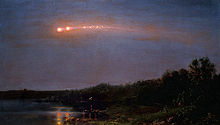
Back شهاب راعي الأرض Arabic Bòlid rasant Catalan Tečný meteor Czech Bolido Lur-harramazkatzaile Basque Bolide rasant French アースグレイジング火球 Japanese 어스그레이징 유성 Korean Meteor muskający atmosferę Polish Коснувшийся метеор Russian Dotyčnicový meteoroid Slovak

An Earth-grazing fireball (or Earth grazer)[2] is a fireball, a very bright meteor that enters Earth’s atmosphere and leaves again. Some fragments may impact Earth as meteorites, if the meteor starts to break up or explodes in mid-air. These phenomena are then called Earth-grazing meteor processions and bolides.[1] Famous examples of Earth-grazers are the 1972 Great Daylight Fireball and the Meteor Procession of July 20, 1860.[1][3][4]
- ^ a b c "Texas State astronomers solve Walt Whitman meteor mystery : University News Service : Texas State University". Archived from the original on 2011-10-19. Retrieved 2013-10-19.. Txstate.edu (2010-05-28). Retrieved on 2013-10-19.
- ^ Nemiroff, R.; Bonnell, J., eds. (2 March 2009). "Earthgrazer: The Great Daylight Fireball of 1972". Astronomy Picture of the Day. NASA. Retrieved 2013-10-19.
- ^ "Images of Harper's Weekly front page story". Archived from the original on 2014-04-28. Retrieved 2017-08-26.
- ^ 150-year-old meteor mystery solved